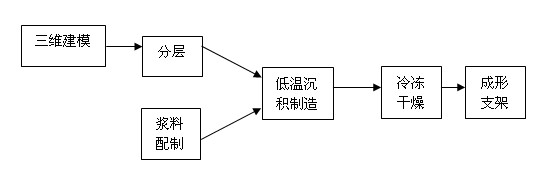Preparation method of mulberry silk tissue engineering scaffold
A technology of tissue engineering scaffold and mulberry silk, applied in medical science, prosthesis, etc., can solve the problems of low porosity of scaffold model and inability to make models
- Summary
- Abstract
- Description
- Claims
- Application Information
AI Technical Summary
Problems solved by technology
Method used
Image
Examples
example 1
[0023] 1) Directly design with the help of 3D CAD software or use solid reverse engineering to collect the geometric shape and structural information of the prototype to obtain a 3D model.
[0024] 2) According to the above-mentioned three-dimensional model and the specific needs of the bracket, perform layering to obtain the data file formed by the low-temperature forming machine. In the layering, set the layer thickness to 0.19mm, the distance between wires to 1.3mm, and the scanning angle to 0° / 90°.
[0025] 3) slurry preparation, specifically comprising the following steps:
[0026] 3-1) Silk degumming: use 50 times the volume mass fraction of 0.5% Na 2 CO 3 solution, refine the silk twice at a temperature of 95-100° C., each time for 30-40 minutes, and rinse with deionized water for 2-3 times.
[0027] 3-2) Silk dissolution: Dissolve 10g of degummed silk in boiling 100mL CaCl with a mass fraction of 40% 2 solution, the dissolving time is 60-80 minutes, and the silk fib...
example 2
[0034] 1) Directly design with the help of 3D CAD software or use solid reverse engineering to collect the geometric shape and structural information of the prototype to obtain a 3D model.
[0035] 2) According to the above-mentioned three-dimensional model and the specific needs of the bracket, layering is carried out to obtain the data file formed by the low-temperature forming machine. In the layering, the layering thickness is set to 0.17mm, the distance between wires is 1.2mm, and the scanning angle is 0° / 90°.
[0036] 3) slurry preparation, specifically comprising the following steps:
[0037] 3-1) Silk degumming: use 50 times the volume mass fraction of 0.5% Na 2 CO 3 solution, refine the silk twice at a temperature of 95-100° C., each time for 30-40 minutes, and rinse with deionized water for 2-3 times.
[0038] 3-2) Silk dissolution: Dissolve 10g of degummed silk in boiling 100mL CaCl with a mass fraction of 40% 2 solution, the dissolving time is 60-80 minutes, and...
example 3
[0045] 1) Directly design with the help of 3D CAD software or use solid reverse engineering to collect the geometric shape and structural information of the prototype to obtain a 3D model.
[0046] 2) According to the above-mentioned three-dimensional model and the specific needs of the bracket, layering is carried out to obtain the data file formed by the low-temperature forming machine. In the layering, the layering thickness is set to 0.15mm, the distance between wires is 1.2mm, and the scanning angle is 0° / 90°.
[0047] 3) slurry preparation, specifically comprising the following steps:
[0048] 3-1) Silk degumming: use 50 times the volume mass fraction of 0.5% Na 2 CO 3 solution, refine the silk twice at a temperature of 95-100° C., each time for 30-40 minutes, and rinse with deionized water for 2-3 times.
[0049] 3-2) Silk dissolution: Dissolve 10g of degummed silk in boiling 100mL CaCl with a mass fraction of 40% 2 solution, the dissolving time is 60-80 minutes, and...
PUM
 Login to View More
Login to View More Abstract
Description
Claims
Application Information
 Login to View More
Login to View More - R&D
- Intellectual Property
- Life Sciences
- Materials
- Tech Scout
- Unparalleled Data Quality
- Higher Quality Content
- 60% Fewer Hallucinations
Browse by: Latest US Patents, China's latest patents, Technical Efficacy Thesaurus, Application Domain, Technology Topic, Popular Technical Reports.
© 2025 PatSnap. All rights reserved.Legal|Privacy policy|Modern Slavery Act Transparency Statement|Sitemap|About US| Contact US: help@patsnap.com


